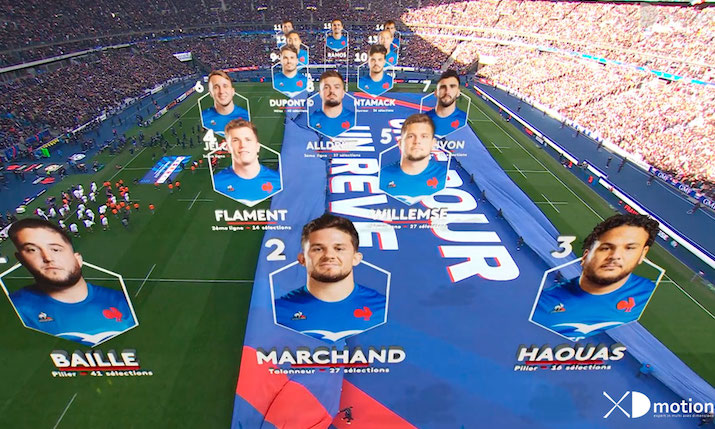2024 and beyond: Sports broadcasting is evolving says XD Motion
 By Andrew Gordon, XD Motion CCO.
By Andrew Gordon, XD Motion CCO.
The sports broadcasting industry is experiencing transformative growth, with emerging technologies enabling incredible and innovative audience engagement trends and strategies from marketers and broadcasters alike.
This evolution is vital in an era where traditional TV viewing times are in decline; for instance, average viewing times dropped from three hours and 17 minutes in 2021 to just two hours and 51 minutes in 2023 [IBM, 2023]. While this can be attributed in part by the pandemic, it is a trend that continues to be an ever-expanding reality.
Additionally, streaming services have officially eclipsed traditional broadcast TV [Nielsen, 2023]. These developments, as well as the continuing trend of gamification and advanced technologies is revolutionizing the way we experience sports broadcasts.
Passive spectators to active participants
Gamification of the sports broadcast experience is shifting viewers from passive spectators to active participants. This interactive approach, encompassing real time polls, predictions, and dynamic conversations, not only enhances the viewing experience but also opens new avenues for monetisation.
The employment of cutting edge technologies, such as cable cams, enhanced camera lensing, and XR-based productions, further elevates this trend. These technologies simulate the once “impossible” shots seen in sports video games, adding a cinematic quality to sports broadcasts.
Advancements in 8K technology, combined with robotics and cable cams, are ushering in a shift that mirrors the immersive world of video games. The integration of 8K cameras provides ultra-high-definition visuals, which are further enhanced by the dynamic capabilities of robotics and cable cam systems. This blend of advanced camera technology and filming techniques is making sports broadcasts more engaging and relatable, especially to a digitally-savvy audience [SB Nation, 2021].
Further enhancing the broadcasting experience, artificial intelligence (AI), machine learning, and predictive algorithms play a crucial role in gamification strategies. They enable real time data optimisation, support decision making, and facilitate smart monetisation models. Technologies like virtual reality (VR) and augmented reality (AR) are reshaping sports broadcasts, offering immersive experiences and interactive elements. Devices such as smartwatches and smart speakers extend the reach of broadcasts, providing additional platforms for interaction and engagement.
Social media and second-screen experiences are becoming integral to modern sports broadcasting. These platforms offer new avenues for fan engagement, with content tailored to attract modern audiences. They create dynamic, organic content generation between international spectators and bridge the gap between the spectator and commentators or analysts.
Significant leap
The adoption of 5G technology is another significant leap in sports broadcasting. 5G’s higher bandwidth and low latency are enabling broadcasters to offer more immersive and interactive viewing experiences. This technology supports high quality live streaming, even in crowded stadiums, ensuring seamless delivery of ultra high definition (UHD) visuals and dynamic camera movements. The integration of 5G is vital in meeting the increasing demand for real time, high quality sports content.
5G and IoT innovations are also transforming the sports and entertainment industries. 5G networks are enabling more immersive fan experiences, particularly in stadiums. Augmented reality is reshaping pregame festivities, as seen with the Carolina Panthers’ debut of a giant AR mascot. 5G connectivity allows fans to share content via social media and access alternative camera angles, audio commentaries, and advanced statistics [Perle.com, 2021]. Research by McKinsey indicates that fans are demonstrating a willingness to pay more for the value of 5G experiences [Perle.com, 2021].
Improved broadcasting is another benefit of 5G technology, particularly in facilitating remote broadcasting. This has become increasingly important due to COVID-19 restrictions. 5G enables more workers to support broadcasts offsite, improving production workflows [Perle.com, 2021].
Moreover, 5G-enabled IoT devices are aiding athletes in their preparation and performance. For instance, Verizon’s 5G technology provided Team Penske with faster, real time data collection, aiding their preparation for the Indianapolis 500 [Perle.com, 2021]. Wearable IoT devices are revolutionising sports like cycling, enabling athletes to make race-changing decisions on the fly.
Key points
- 5G and IoT Enabling New Broadcast Capabilities: The advent of 5G is revolutionising live broadcasts with innovations like drones and remote operations.
- Smart Stadiums Segment Growth: The smart stadiums segment is expected to dominate the market by 2027, especially in Asia Pacific and China.
- Gamification of Live Sports: Emerging technologies are leading to increased fan engagement and new fan adoption.
- Focus on Fan Engagement: Enhancing fan experiences in stadiums is a key driver of market growth.
- Advent of AI and ML Technologies: AI, ML, AR, and VR are presenting significant opportunities in sports broadcasting.

